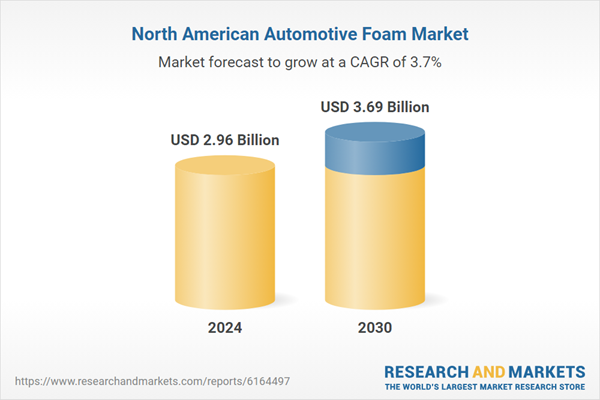Free Webex Call
The North America Automotive Foam Market was valued at USD 2.96 Billion in 2024, and is expected to reach USD 3.69 Billion by 2030, rising at a CAGR of 3.74%. Speak directly to the analyst to clarify any post sales queries you may have.
10% Free customizationThis report comes with 10% free customization, enabling you to add data that meets your specific business needs.
The North America automotive foam market benefits from surging demand for lightweight materials as vehicle manufacturers seek to comply with Corporate Average Fuel Economy (CAFE) standards. According to the U.S. Department of Transportation, new fuel economy targets aim for passenger vehicles to achieve about 58 mpg by 2032, driving adoption of materials like polyurethane foams that help reduce vehicle weight while maintaining performance. Rising electric vehicle production also fuels demand for specialty foams for noise insulation and battery compartment protection.
Sustainability pressures shape significant market shifts. The U.S. Environmental Protection Agency reports that transportation accounts for nearly 29% of U.S. greenhouse gas emissions, leading to rising interest in bio-based and recyclable foams to lower vehicles’ environmental footprints. In line with this, Woodbridge has developed CO2-neutral polyurethane seat foams, indicating how sustainability is becoming a decisive factor in material choices. Innovations in polyurethane formulations and recyclable foams align with manufacturers’ sustainability goals while enhancing cabin acoustics and passenger comfort.
Emerging regulations on volatile organic compounds (VOCs) in interior automotive materials pose challenges. The U.S. EPA has issued stricter guidelines on VOC emissions for vehicle interiors, raising production costs for foam manufacturers striving to comply. Meanwhile, fluctuations in raw material prices for isocyanates and polyols remain a key risk, as noted in statistics from the U.S. Bureau of Labor Statistics, which indicates petrochemical feedstock price volatility continues due to global supply chain dynamics. Despite these headwinds, foam producers are exploring advanced chemistries to balance performance, compliance, and cost-effectiveness.
Market Drivers
Demand for Lightweighting in Automobiles
Automakers target fuel efficiency and emission reduction to meet regulatory mandates like the U.S. CAFE standards, which demand higher fuel economy. Lightweight automotive foams, particularly polyurethane and polypropylene types, contribute significantly to lowering vehicle weight. The U.S. Department of Energy reports that every 10% reduction in vehicle weight can improve fuel economy by 6-8%, increasing the attractiveness of foams for both internal combustion and electric vehicles. This regulatory and economic push incentivizes manufacturers to integrate lightweight foam materials for structural parts, interiors, and acoustic applications.Key Market Challenges
Volatility of Raw Material Prices
Automotive foam manufacturing relies on petrochemical derivatives like isocyanates and polyols. The U.S. Bureau of Labor Statistics reports fluctuating crude oil prices influence costs for foam feedstocks. Supply chain disruptions, geopolitical conflicts, and refinery shutdowns have caused significant volatility. This unpredictability squeezes profit margins and complicates long-term contract pricing for automotive manufacturers and suppliers. Frequent price adjustments challenge procurement strategies and elevate production costs, prompting industry stakeholders to explore alternative chemistries and more stable bio-based feedstocks.Key Market Trends
Development of Bio-Based Polyurethane Foams
Foam producers are accelerating research into bio-based polyurethane foams using renewable feedstocks like soy polyols. The U.S. Department of Agriculture reports growing market interest in bioproducts to reduce reliance on petrochemicals. These bio-based foams promise comparable performance to traditional materials while improving sustainability profiles. Automotive OEMs incorporate such foams to align with environmental targets and meet consumer demand for eco-friendly vehicles. Bio-based foams represent a notable shift in automotive materials innovation, creating new product categories and potential cost efficiencies for manufacturers.Key Market Players
- BASF SE
- Bridgestone Corporation
- Covestro AG
- Dow
- Huntsman Corporation
- Recticel
- Rogers Corporation
- Saint-Gobain
- Vita (Holdings) Limited
- Woodbridge Foam Corporation
Report Scope:
In this report, the North America Automotive Foam Market has been segmented into the following categories, in addition to the industry trends which have also been detailed below:North America Automotive Foam Market, By Application:
- Interior
- Exterior
North America Automotive Foam Market, By Type:
- Polyurethane Foams (PUFs)
- Expanded Polypropylene Foam
- PET Foam
- Others
North America Automotive Foam Market, By Country:
- United States
- Canada
- Mexico
Competitive Landscape
Company Profiles: Detailed analysis of the major companies present in the North America Automotive Foam Market.Available Customizations:
North America Automotive Foam Market report with the given market data, TechSci Research, offers customizations according to the company’s specific needs. The following customization options are available for the report.Company Information
- Detailed analysis and profiling of additional market players (up to five).
Table of Contents
1. Introduction
2. Research Methodology
3. Executive Summary
4. North America Automotive Foam Market Outlook
5. United States Automotive Foam Market Outlook
6. Mexico Automotive Foam Market Outlook
7. Canada Automotive Foam Market Outlook
8. Market Dynamics
12. Competitive Landscape
Companies Mentioned
- BASF SE
- Bridgestone Corporation
- Covestro AG
- Dow
- Huntsman Corporation
- Recticel
- Rogers Corporation
- Saint-Gobain
- Vita (Holdings) Limited
- Woodbridge Foam Corporation
Table Information
| Report Attribute | Details |
|---|---|
| No. of Pages | 130 |
| Published | August 2025 |
| Forecast Period | 2024 - 2030 |
| Estimated Market Value ( USD | $ 2.96 Billion |
| Forecasted Market Value ( USD | $ 3.69 Billion |
| Compound Annual Growth Rate | 3.7% |
| Regions Covered | North America |
| No. of Companies Mentioned | 10 |









